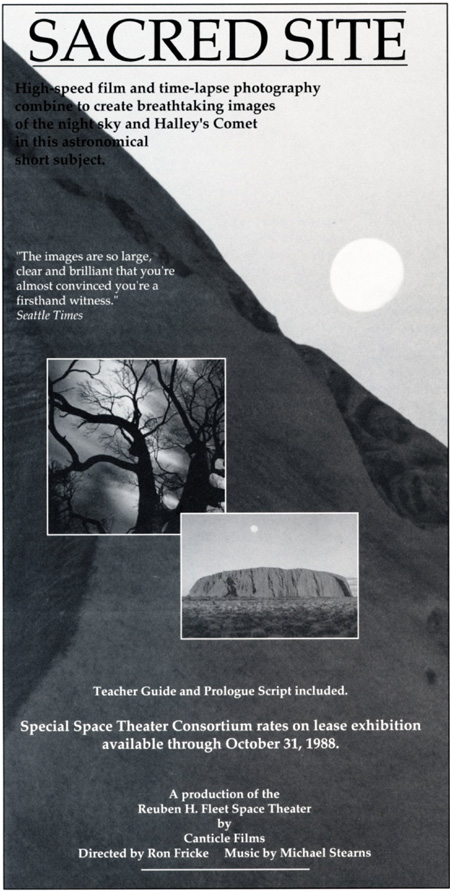"Sacred Site", A short film in 65mm Omnimax | Read more at in70mm.com The 70mm Newsletter |
| Written by: The Big Frame, 1986. Reprinted with written permission from Kelly Germain, Giant Screen Cinema Association | Date: 21.08.2011 |
 The Reuben H. Fleet Space Theater and Canticle Films, Inc., have launched an
OMNIMAX/IMAX time-lapse film project to cinematically explore the range of
light and motion in the night skies. Focusing on the 1986 apparition of
Halley's Comet over central Australia, the four-week production effort was
directed by "Chronos" filmmaker
Ron Fricke at Ayers Rock, sacred site of the
Aborigines (and comet watchers from all over the world). The Reuben H. Fleet Space Theater and Canticle Films, Inc., have launched an
OMNIMAX/IMAX time-lapse film project to cinematically explore the range of
light and motion in the night skies. Focusing on the 1986 apparition of
Halley's Comet over central Australia, the four-week production effort was
directed by "Chronos" filmmaker
Ron Fricke at Ayers Rock, sacred site of the
Aborigines (and comet watchers from all over the world).The short film (three to five minutes in length) has the working title "Night Fires," drawn from the Aboriginal mythology which considers the stars to be the campfire of those who inhabit the sky world. Images of a surprisingly bright comet are set near the majestic Milky Way of the southern night sky and contrasted by the spectacle of a total lunar eclipse. "Chronos" composer Michael Stearns will create the soundtrack for "Night Fires." Michael Glasheen of Tetravision in Australia was field producer. For details on distribution please contact Dr. Jeffrey Kirsch at (619) 238-1233. | More in 70mm reading: "Baraka" cast and credits "Samsara" to Premiere in Canada, September 11, 2011 An Interview with Ron Fricke A Conversation with Mark Magidson and Ron Fricke Internet link: Magidson Film: "Samsara", "Baraka" and "Chronos" giantscreencinema.com |
"Sacred Site" credits | |
 Original titel: Sacred Site. Working Title: Night Fires.
Retitled: Night of the comet. New US title from around May 1992. Filmed in: 65mm 15 perf.
Principal cinematography filmed in: Omnimax. Presentation format: Omnimax.
County of origin: USA. Year of production: 1986. Danish premiere: 31.10.1989.
Premiere cinema: Tycho Brahe Planetarium. Original titel: Sacred Site. Working Title: Night Fires.
Retitled: Night of the comet. New US title from around May 1992. Filmed in: 65mm 15 perf.
Principal cinematography filmed in: Omnimax. Presentation format: Omnimax.
County of origin: USA. Year of production: 1986. Danish premiere: 31.10.1989.
Premiere cinema: Tycho Brahe Planetarium. Producer: Ron Fricke. Director: Ron Fricke. Director of photography: Ron Fricke. Film editor: Ron Fricke. Music composed and performed by: Michael Stearns. Production company: A Canticle Films, Ltd. production for The Reuben H. Fleet space theatre. Executive producer: Jeffrey W Kirsch. Camera/Editing assistant and production coordinator: Steven Marble. Camera system: Canticle Film Productions, Inc. Sound system: six-track magnetic stereophonic sound. Soundtrack: Recorded and mixed at M'Ocean Studio, Santa Monica, California, USA. Transfers: Joseph Piantodosi, Lions Gate Films. Field producer Australia: Michael Blasheen. Filming locations: Ayers Rock, Australia. Additional astro cinematography filmed at Siding Spring Observatory. Filming periode: April 1986. Studio manager and production coordinator: Debra Jean Rawdin. The producers wish to thank: The astronomers: Clint Hatchet, Graham Mercer, Steven Lee, Greg Welch, Donn, Reiners, Steven Beuznberg. United States: Institute for astronomy University of Hawaii. Haleakala Observatory Dr Don Hale, Director. Dave Garcia machinist, Dave-CO Precision. Jimm Sorensen MGM Laboratories, Moldex/Metric, Inc. Australia: Australian National Parks and Wildlife service. Ayers Rock, Northern Territory. Lynn Baker and Chip Morgan. Australian National University Observatory, Siding Spring, New South Wales, Dr. John Dawe, Director. Halley's watch site, Ayers Rock, Northern Territory. Optical printing: Imagica Corporation, Tokyo, Japan. 70mm prints: MGM Metrocolor. Color timer: Bill Pine. Distributer: 1986: Reuben H. Fleet space theatre, San Diego, USA. 1993: Destination Cinema. Synopsis: High speed film and time-lapse photography combined to create breathtaking images of the night sky and Halley's Comet in this astronomical short subject. | Credits assembled by Thomas Hauerslev |
| Go: back - top - back issues - news index Updated 22-01-25 |
